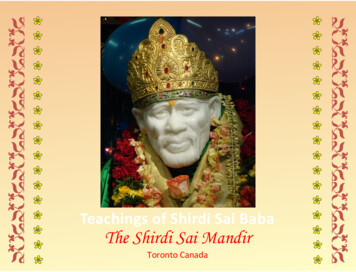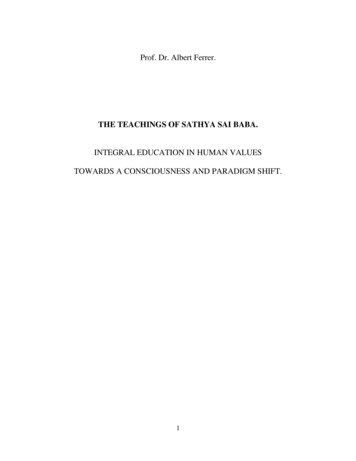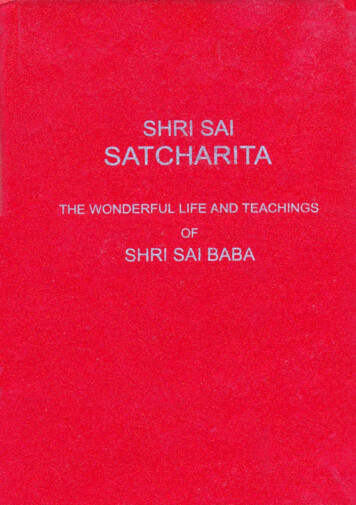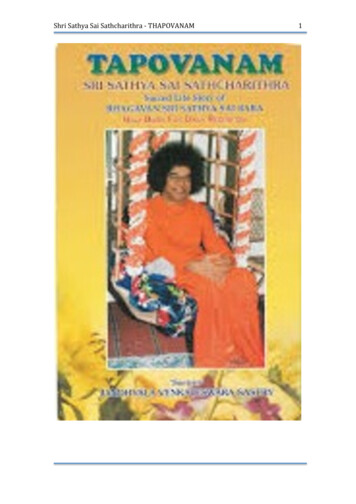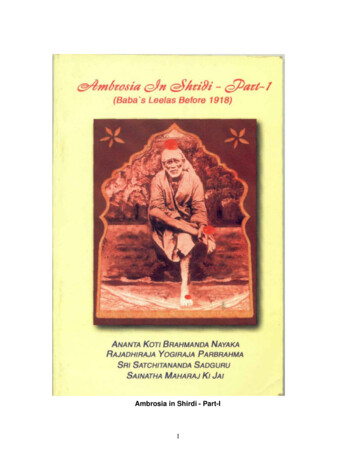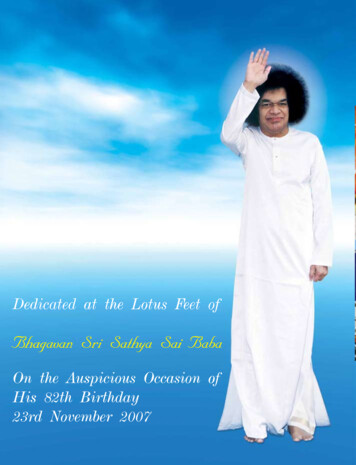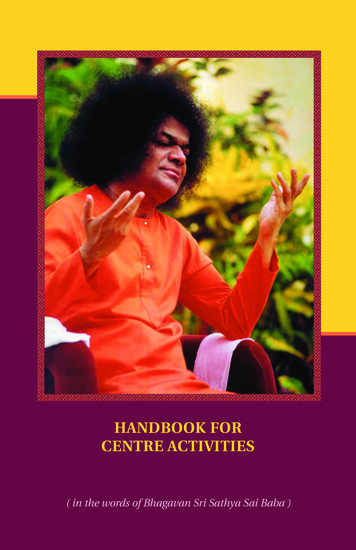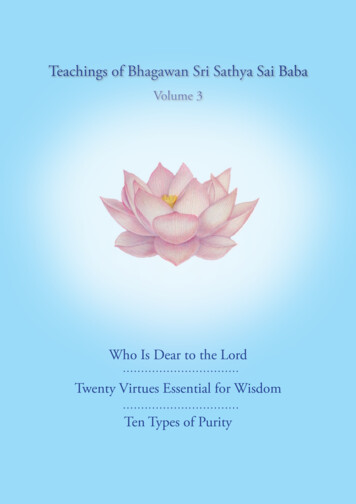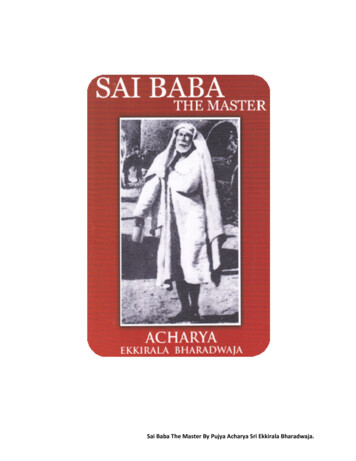
Transcription
Sai Baba The Master By Pujya Acharya Sri Ekkirala Bharadwaja.
INDEXIntroduction1. The Master Calls Me2. Sri Sai Baba – A Sketch of His Life (I)3. A Sketch of His Life (II)4. The Call of The Guru5. The Refuge of His Devotees6. I am ever with you7. The Guru Is All Gods8. Sai Baba is in all Saints and Sadhus9. Baba is all creatures and things10. Baba’s Omniscience11. Sai Baba’s Daily Life12. Sai Baba The Man and The Master13. The Master and His ways of Teaching14. The God-man and Tradition15. Sayings of Sai Baba16. At the Threshold of Eternity17. The Off-shoots of Sai Baba18. The Tomb that Speaks and Moves19. The Power of Satsang20. The Harbinger of Grace21. Sai Baba the Eternal Symbol22. Appendix I to Appendix VISai Baba The Master By Pujya Acharya Sri Ekkirala Bharadwaja.
Sai Baba The MasterBy Pujya Acharya Sri Ekkirala BharadwajaIntroductionIMan, in the first flush of scientific advancement, has considered religion to be a relic ofsuperstition of primitive humanity. Today, the very advance of science has brought back thesense of awe and wonder at the immensity of the cosmos. Every step forward in science hasmade us aware how imperfect and tentative our knowledge has been, and is bound to be. Theuniverse, with its mind-shattering dimensions, distances and speeds, down to the sub-atomicparticles is basically a mystery.That our knowledge should be incomplete can be easily understood: If the entire history of lifeon earth be equated to a hundred years, man’s history occupies about a hundred minutes and thatof modern science, a mere two seconds. That our knowledge is bound to be imperfect andincomplete can also be understood: “We know nothing of the universe beyond the effects that itshappening produce on our senses, either directly or through the intervention of instruments,”says Sir James Jeans. The sense organs register the various stimuli as vibrations and convey themto the brain. Our mind assembles its image of the external universe from them. The range ofperception of our sense is very limited and there are bound to be vibrations which they cannotcapture. Thus our experience of the universe is only a fraction of what it is; that too, a subjectiveprojection of it. For we never can experience the source of even the vibrations that our sensesgather.This brings us to our knowledge of ourselves. Psychologists tell us that we are aware of only aminute fraction of our psyche, our being, i.e., of our potential for knowledge. Ancient spiritualphilosophy which underlies religions and is confirmed by all great saints has a lot to offer us inthis realm. It tells us that while our common means of knowledge is the mind functioningoutwards through the senses, perceiving the discreteness of things in nature, the introverted mindof the saint goes deep down to the spiritual core of our being and experiences the spiritual unityof all that is. The latter thus realizes that Reality is normally veiled by the very make andfunctioning of our senses and by our normal awareness which is conditioned by them. In themystic experience, on the other hand, man recognizes his identity with the Reality of allexistence. The common form of knowledge is knowledge of particular things and does not affectour being, while mystical experience is knowledge of the unity of all existence which alchemizesour being. It transcends the limitations of individuality and leads to profound bliss and ‘peacewhich passeth understanding’. The genuine spiritual experience of great mystics and even ofsome common individuals should enable us not to confuse their knowledge with the subjectivedelusions of deranged minds. The perfect blossoming of spiritual values in a genuine mystic, thepeace and bliss he experiences and emanates are the promises which spiritual life holds out tohumanity.Sai Baba The Master By Pujya Acharya Sri Ekkirala Bharadwaja.
IIThe significances of an accomplished mystic to religion is inestimable. All major religionssprang from the mystic experience of such - the Rishis of the Vedas and Upanishads; the Mastersof Taoism, the Buddha, the Christ and prophet Mohammad. All religions are sustained too, fromtime to time, by the saints who demonstrate in their lives, the truth of the promise of religiouslife, that any mortal can realize the Spirit through genuine effort. The individual seekers tooderive the true interpretation of the scriptures from the lives and teachings of such. Upanishadssay that a disciplined seeker has to seek the guidance of a realized sage and Sri Krishna says thesame in The Bhagavadgita (ch. iv : 34). The third of the three vows of Budhism, “SanghamSharanam Gacchami”, affirms the need to seek the association of the wise. The Chirst says, “Noone can come to the Father save through me”. He finds it so essential to spiritual life that hechooses to seek baptism from John the Baptist “for righteousness’ sake”. The esoteric school ofIslam, Sufism, enjoins a seeker to resort to the Pir-O-Murshad. Even modern saints like GuruNanak and Sri Ramakrishna Paramahamsa were divinely directed to Masters even at anadvanced stage of sadhana.The point is driven home even more powerfully in world’s mythologies. In Hinduism, LordDattatreya is the Avatar that manifests Himself to awaken and lead mankind to the verities ofspiritual life. It is he that reveals himself in all the world’s perfect masters of wisdom. The Budhaand the Bodhisattvas are said to reincarnate for the same end. Every Christian saint had declaredat the moment of realization that Christ lives in him and not he. Sai Baba of Shirdi hasdemonstrated that the One spirit of wisdom of all saints is He.Further, all the world’s mystical works say that association with a Master is of greater value thanthe study of scriptures. For the Master interprets the scriptures in a manner which is appropriateto his times and to the individual seekers and thus enables them to live up to the spirit (ratherthan the letter) of religion.IIIYet it is hard to recognize genuine spiritual masters among the teeming half-baked ones withfalse claims. It is the latter class that make organized religion an odious mess that repels thecultured today. To help the common seekers to find genuine Masters, all religions have adoptedsome common means. Firstly, the lives and teachings of great masters bring into relief the hallmarks of such a one. Some scriptures even clearly spell them as The Bhagavadgita does thequalities of a sthithaprajna, or one who is firmly established in wisdom.Even with this help, not all can discern a true Master, For there are several clever ones who cansuccessfully deceive people - “wolves in the lamb’s coat”, as the Bible says. Here certainreligious traditions have pointed to a higher law which can help. It is said that when the seeker isearnest in his efforts and ripe to receive the Master he is sure to arrive. The Bridegroom knocksand we have to be watchful. All that we can and ought to do lies in preparing to receive theMaster.Sai Baba The Master By Pujya Acharya Sri Ekkirala Bharadwaja.
The most potent means of self-preparation is the devout and intelligent study of the lives andteachings of the great Masters. The Master is the bridge between the human and the Divine,objectively. When a seeker reads his life, the human in the seeker intuits and intuitively contactsthe Divine in himself and the inner bridge is thus built. When the process is complete, hisaccomplishment is corroborated by the external contact with the Master and eventually, theexternal and the internal become one. The Master is thus within (as “the Kingdom of heaven” is)and without (as the Christ is) too. The Master and the seeker thus become one in the Spirit.In the earlier stages of such reading, the seeker is charmed by a vision, in the Master, of his owninfinite spiritual potentialities being realized and is thus spurred on to zealous, optimisticendeavour. The infinite power and love of the Master grips the seeker’s heart in steadfastdevotion. From the lay stage of craving for worldly good in prayer, he becomes a true seeker ofthe Divine which is Love and Bliss, for its own sake. Such a one would most willingly bear thecross of worldly suffering, his heart set on the goal, the end of all sorrow, and follow the Master.Let us remember that all true Hindu, Buddhists, Christians and Muslims are people who aredrawn to true religion by the lives of the sages, the Buddhas, the Christ and the Prophet. Thistradition is represented by the works, Sri Gurucharitra in Maharashtra (India), and byPeriyapuranam in Tamilnadu. In ancient India The Gurugita and The Bhagavata were widelyused for the purpose. The instances of readers who were divinely directed to their Masters bysuch study are legion. The most famous is the instance of young Venkataraman being galvanizedinto an ardent seeker by a study of The Periyapuranam and, after his subsequent Self-realizationwhich can be traced to it, he became famous as Sri Ramana Maharshi.The immediate presence of a sage is a myriad times more effective than all of one’s own spiritualendeavours. Sri Ramakrishna Paramahamsa and Sri Ramana Maharshi were emphatic about it.But such association is not possible for all to the needed extent. To one such, Sri RamanaMaharshi said, “Satsang is association with the Divine Reality which is eternal and omnipresent.To be aware of it at all times is satsang. Devout study of lives of those who are realized too canconstitute satsang, or association with the enlightened ones.”To most of us, the study of the lives of perfect masters is even more effective. For human naturebeing such, even when we live with a sage, we tend to focus our attention more on his physicalframe than on his realization which is the essence of it all. Even the apostles of Christ falteredwhen their boat was tossed by a storm and the Christ chid them as those of “little faith”. Arjunaconfesses to such an error in regard to Krishna in The Bhagavadgita. But when we study the lifeof a Master, we unfalteringly focus our attention on the Supreme wisdom-in-action which is theMaster. Thereby, we are trained to do the same when we eventually contact a living Master, as ithappened in the case of Sai Baba; or our contact with the Master might remain at a purelyspiritual level and alchemise us, as happened in the case of Sri Ramana Maharshi. For when adevotee asked the sage how he happened to realize without the help of a guru, he said that he toohad one, though not in the form which the devotee expected.Sai Baba The Master By Pujya Acharya Sri Ekkirala Bharadwaja.
IVIn this context, the life of Sri Sai Baba of Shirdi, I feel, is unique. He does not merely teach aboutthe omnipresent Spirit. Indeed, his verbal teaching is minimal. For there are scriptures galore todo that. But mere verbal teaching cannot strike deep root in the hearts of common folk. Sri SaiBaba has therefore taught through direct experiences. He baptized mostly through the HolyGhost. He showed unerring, at-one-ment with all gods of Hindus, all saints, all creatures andeven with so-called inanimate objects. He was ever aware of what transpired within and withouthis devotees everywhere. His devotees had no choice but to be aware of an omnipresent andomniscient Baba. The result is that at one stroke, their conduct and attitude to fellow-creatureswere bound to conform to the highest codes of altruism. Wherever the devotee was, he was madeto recognize that Baba was, in spirit, with him indeed. The implications of this aspect of Baba arerich beyond measure. The heart of all spiritual endeavour is to cultivate the presence of the Spirituninterruptedly and this was secured for the Sai devotee - how remarkably, the succeedingchapters illustrate.Beside this, the manifestation of the Spirit as Sri Sai Baba is unique in another respect. No oneknows his caste, creed, or parentage. This anonymity lent a strange facet to his teaching. To theHindus he was an orthodox brahmin with sacred fire, enjoining the worship of the many godsand the devout study of various Hindu scriptures; he even named the mosque as Dwarakamaiand planted the Tulasi in its frontyard and then allowed himself to be worshipped by his devoteesin the Hindu fashion. To the moslems, he was a moslem, a pir, living in a mosque, observing thediscipline enjoined for a fakir, always uttering the Islamic Allah Malik, guiding moslem seekerslike Abdul Baba along the Islamic line. To the Parsis, he was the sacred fire-worshipper. His life,too, is a living manifestation of the Sermon of the Christ and of the eight fold path of theBuddha. Thus, in him we have a perfect model of harmony of all religions for whom this world,with all its sectarian and religious antagonisms, has been looking forward.A third feature that specially belongs to him is this: Most of the religious scriptures and holy menseem to suggest that one ought not to aspire for this or that material goal, in being devoted to aguru or god. Sri Sai Baba never laid down such a rule. Indeed, once, when a self-assured devoteedissuaded a few visitors who came to Sai Baba for the fulfilment of material needs, the Mastertold him not do so.The fourth unique feature is the phenomenally large number of instances in which the great fakirhas been physically appearing before his devotees, even decades after his mahasamadhi literallyfulfilling his verbal assurance on the great event.VThe writer expresses his thanks to the Sai Baba Samsthan, Shirdi, All India Sai Samaj, Madrasand Sai Spiritual Centre, Bangalore, for the kind permission accorded to him to utilize thematerial available in all their publications and journals. Thanks are also due to all other writers ofbooks published in Hindi, Gujarathi and Marathi for the material drawn from them. My specialthanks go to those devotees of Baba, like Sri Marthand Mahalsapathi, Sri Nanasaheb Rasne, lateSri Sai Sharananandaji, who shared the reminiscences of their life in the immediate presence ofSai Baba The Master By Pujya Acharya Sri Ekkirala Bharadwaja.
Baba. Finally, I acknowledge with thanks the immense assistance extended to me by SriSivanesan Swami of Shirdi in reading out to me from the back numbers of “Sai Leela” (Marathi),the official organ of the Sai Samsthan, Shirdi.The Master Calls MeMy quest for truth was awakened by the tragic demise of my nephew in 1955 on the occasion ofmy initiation (sacred thread) ceremony. Now I see, in retrospect, that it was indeed an initiation.The initial heartbreak had left and, in its wake, several fundamental questions arose in me: “Isthere a Supreme Spirit? What is the nature? How can we contact it? What is life? What is death?Is there a soul? Why hasn’t man found a way out of death? What is Time?” and such others. Thesearch went on unanswered till 1960. One evening in that year, when I was taking a stroll,something mysterious occurred somewhere deep in me and all the questions vanished in a triceand peace prevailed. These questions seemed out of place, of no value any longer. A book onZen which came to my hand quite unasked for, contained a description of inner illumination orsatori which came nearest to my experience. It was a pleasant surprise and a promise. The questtook on a richer hue.In 1963, my elder brother Sri E. Vedavyas invited me to join him on his visit to Shirdi. Though Ihad little faith in saints at that time, I consented just to give him my company. On the 8th ofFebruary we reached Shirdi at sunset and we went straight to the samadhi mandir to attend thearti. The deep faith that shone on the faces of the congregation for the saint who left off hisphysical frame nearly half a century ago, was surprise to me. Soon after, the devotees dispersedand the shrine was mostly empty. My brother showed me the tomb at close quarters and told methat Shri Baba’s mortal remains were kept in it. That being my first close look of a tomb, I wasshocked. My first reaction was to imagine in what a putrefied condition the body must havebeen. The marble structure of the tomb and the profuse incense that was burnt there made mesuppose that it was intended to keep out any stench that might possibly leak out. The thought wasrevolting and nauseating. I at once took leave of my brother and slept in the room, unable even torelish food, in the wake of the shock.Next morning, a keen apetite woke me up and I made straight for the Madras hotel. As I passedbefore the samadhi mandir, I found that the morning arti was over and the place was almostvacant. The sight of the marble statue over the samadhi attracted my attention and I wanted tohave a close look at the form that continues to charm so many devotees. I stepped in and stood ata little distance from the statue and looked at it. It is quite life-like and I felt that the saint musthave looked precisely like that. The sculptor must have been divinely inspired in capturing thatmysterious smile and the inward look. The look captured my gaze. “What does his face,especially his look and smile, indicate of his attitude? Was he elated that so many visited him topay their homage, adore and worship him? Or was he overwhelmed with compassion for them?Or, in that mood, was he oblivious of his separate existence, his gaze fixed on the divinemystery, the one omnipresent spirit? Or was it a look of recognition of that ancient spirit, of hiscontacts with those teeming crowds that had contacted him through their countless previousSai Baba The Master By Pujya Acharya Sri Ekkirala Bharadwaja.
lives? And, was that smile of reunion pregnant with his joy of their future possibility of reachingthe spiritual summit? Or was he just oblivious of all this, lost in his ceaseless contemplation ofthe one spirit, in his at-one-ment? And is the mysterious Monolisa-smile a manifestation of thatpeace which passeth understanding? Or is there a possibility that at a higher level ofconsciousness all these attitudes could coexist without the one interrupting the other?”This last thought flashed with a particular intensity and my spirit leapt forth to comprehend how,in that state, he was viewing all this existence: “Is the universe of myriad forms an imageprojected in his consciousness? And am I, then, too, a thought in his Mind and are all these mythoughts parts of it?” The intuition took off and wafted my being into far-off states. I knew ofnothing else. My being was still, taut with a particular illumination and my thoughts were bothexistent and non-existent. I am aware how absurd these words must look to anyone. But whatelse can they be when I verbalize what cannot be conveyed?Quite some time lapsed in that timeless moment and I was knocked back into normal awarenessby what they felt to me like a rude knocking on my shoulders. It was then that I realized that Iwas seated and that my eyes were shut, that my cheeks were wet with half-dried tears. The shrinewas quite noisy and crowded. I saw my brother patting me gently and asking, “You are stillseated here! Had your bath and breakfast? It’s almost lunch time. It’s better to finish our lunch.”His words were quite audible but I found it hard to catch the sense, as though I was abruptlyawakened from deep sleep. It was quite disturbing even to endeavour to understand the wordsand still more to respond, the spirit being totally unwilling to be called out from the heart ofpeace. It was much easier to just obey what he said. It was nearly four hours since I stepped intothe shrine which was getting crowded as the time for noon arti was nearing and the devoteeswere queing up for finishing abhishek! We walked down to the dining hall but to me it was asthough the walk were just a vivid reverie. My mind was all set on sinking back into the state ofpeace and bliss from which it was roused and with which the connection was not yet completelysnapped. It was quite a task to pay particular attention to things and persons.This mood was persistent and had never quite left me during the brief stay of two days at Shirdi.Perhaps my brother had found out that something unusual was happening to me. “You may goover here again later if you want to, but now we have to go back!” he said. And we were back.The significant thing, as I see it now in retrospect, is that the spiritual connection with thatdeeper level of being, continued for months after our return from Shirdi. My mind, when it nowand then relapsed into normal awareness, quite instinctively identified that deeper level of Beingwith Baba. Mostly I was in a continuous state of ineffable peace and quiet and the normalactivities of the day were powerless to interrupt it. Days passed as a continuous moment oftimelessness; it was as though all things around, including my body, were all parts of a wholewhich is conscious and aware. Whenever the world around had plucked me into the every dayreality, my spirit, once again, at the earliest possible, was summoned back to its pristine state bythe vivid appearance of the marble image at Shirdi before my mind’s eye. And then objects andcreatures all around would seem to be crystallizations of a pervasive consciousness.Sai Baba The Master By Pujya Acharya Sri Ekkirala Bharadwaja.
This experience was accompanied by a remarkable change in my physical constitution. My leanframe got filled in with flesh to robustness and I was brimming with energy which was notlowered by late hours of reading at night or by missing my meal now and then. There was astrong urge to walk and walk, almost endlessly, through most of the day and I was not tired. Mymind was engrossed in the blissful peace and was not stirred by the traffic on the road. My mind,too, seemed to have grown unusually penetrating. For, the most vexatious of meta-physicalquestions got cleared in a wink and there seemed practically nothing which it could notcomprehend. Often knowledge concerning my friends who were far off, or of the thoughts thatpassed through my associates’ minds broke in and then I was no less surprised at it than they.Strangely enough, the pervasive peace was shared by all those around me. It was definite that mylife turned a corner. The steady current of this experience has ever continued, sometimes quitevivid and sometimes a little less so.After three or four months followed my second visit to Shirdi. This time no such spectacularexperience occurred but I keenly felt that I was visiting a saint who has been my guiding Spiritthrough lives, that he was somehow connected with my initiation into the quest for knowledgeeight years earlier. There was only an intense personal attachment to the Master, and the sense ofnot having the good fortune of seeing Him in flesh and blood in this life. “What could havehappened then? Now that I cannot hope for this, could I at least see any living saint? What wouldbe his impact on me?” This was the object of my prayer at Baba’s samadhi mandir.The response was prompt and striking, as has always been characteristic of him. During the yearsthat followed, I could come into close contact with numerous saints and bask in their blessings:Mother Anasuyadevi of Jillellamudi, Sri Ranganna Babu (a great Ramabhaktha of Guntur), thelate Avadhuta Swami of Chirala, the guru of the Chinthapalli forests of Sileru area, Sri SwamiPurnananda of Srisailam, his guru Sri Rakhadi Baba who stayed at Ganeshpuri, Sri Satya SaiBaba, the two Balayogis of Mummidivaram, the Senior Sankaracharyaji of Kanchi, Sri MaAnandamayi, Sri Akhandananda Saraswati of Muthra, the recluse saints of Kalahasthi andCuddapah, the recluse woman saint of Chivatam, Sri Samartha Narayana Maharaj of Harihar,and the Saint of Poondi. Besides, I had darshan of some famous devotees of Sri Sai Baba. I sawothers like Mother Revati Amma of Madras, and Sri Gulab Maharaj of Nagpur. It is not possibleto detail here my experiences with these saints, but one significant feature in all these was I couldwin their gracious attention only after specifically praying to Sri Baba for the same. Baba wasthus once more proving three things simultaneously; he is still alive in spirit and would gladlybless us with the best at our hearty praying; that he is still one with the being of the saints oftoday even as he was when he lived in flesh and blood; that he can be a competent guru orMaster (Samarth Sadguru) to his ardent devotee even today. For a time, a few friends told methat I was on a “saint-gathering” spree and not stabilized on any one. I was not effected by thiscriticism. Now in retrospect, I am happy to find that, fortunately, my faith in Baba, if anything,grew deeper and has been constant all through. Baba’s invisible hand was leading me to actaccording to the scriptural injunction;Sai Baba The Master By Pujya Acharya Sri Ekkirala Bharadwaja.
"Just as the bee which is fond of honey moves from flower toflower, the disciple who is fond of wisdom goes from Master(Guru) to Master".- Sree Gurugita.I shall mention a few instances of Baba’s grace during these years.In 1968 I resigned my job and lived at the ashram of a mother for an year. After that, on aspecific indication from Baba I left the ashram and settled in my present job here, at Vidyanagar.At first I was very much disappointed with the life here which had stifled my spiritual longings.There was none who shared my aspirations, none to join me in satsang. Life looked dreary andbarren even like the rocky soil here. I yearningly prayed to Baba either to take me to a placewhere I could have satsang or to secure it here for me. Within a few months there was Baba’sresponse in the most seemingly casual manner. A Christian boy, a student, started criticizing mefor adoring a human being like Sai Baba. A discussion ensued which went on for days and drewlarge numbers of students to participate in it. Out of these a small group took shape and decidedto have weekly satsang (devotional or spiritual gathering) on Thursdays for bhajan. The bhajan,by the grace of Baba, has been going on for the last nine years without interruption even for oneweek. The situation was so moulded that I happened to rent the house myself, Baba’s grace hasbeen manifesting in the most miraculous ways to the participants in the bhajan.One Thursday, after bhajan, Baba inspired me to declare to the participants: “if all of us praywith all our hearts, great saints would come here and bless us instead of our going to them. Weare sure to come into contact with great saints.” Baba has been keeping up his word as illustratedbelow.In 1971, I started for Mummidivaram (in East Godavari Dt. A.P.) to have darshan of SriBalayogi on the holy Sivaratri day. On the way I stopped at Guntur to see Sri Ranganna Babu, agreat devotee of Sri Rama, and invite him to visit Vidyanagar. “I shall seek the permission of myguru Sri Rama and, if he permits me, I shall go to Vidyanagar. It is not in my hands to say ‘yes’or ‘no’. Many eminent people come from Hyderabad, Madras and other place to take me therebut generally Sri Rama does not permit me to go”, he replied. I said, “I shall see you again on myway back from Mummidivaram. You please ask Sri Rama. If he is pleased with the devotion ofthe students at Vidyanagar, he would agree”, and took leave of him. All that I could do was topray to Baba. He demonstrated while he was in flesh that he was all the saints and gods. So heshould inspire Sri Ranganna Babu through Sri Rama to visit my place.Again the response was striking. On the third day, I saw Sri Ranganna Babu on my returnjourney. He was the first to greet me gleefully, “Sir, Sri Rama has permitted me to go with you!‘Ranganna’, he said, the students at Vidyanagar, are doing bhajan with devotion. Go, see them’.And he gave me grapes to be distributed to the devotees!” So saying he at once started with me.Sai Baba The Master By Pujya Acharya Sri Ekkirala Bharadwaja.
He had spent two days at Vidyanagar, stepped on a plot of land and said, “Here would spring upan ashram and a mandir! Great yogis will visit this place and great religious ceremonies likeyagnas will be performed here.Another instance: On the evening of 26th July, 1975, we were doing satsang at my house. I wasreading out to the gathering the chapter entitled, “Sri Sai is in All Saints” from my present bookon Baba. Just then we had finished reading the leela (miracle) of Baba’s transfiguration as SriGuru Gholapswami to one Mule Sastry. A small van stopped before my house and some onethere announced, “The Swami has come!” When I came out I saw the saint Sri SamarthNarayana Maharaj of Harihar. He entered our satsang hall, sat on my mat (darbhasana) andblessed us with his presence for full two hours. He too said, “Here will spring up a fine mandirand great souls will come and stay here”. Sri Narayana Maharaj is the twelfth incumbent of theseat at Harihar and he belongs to the tradition of Sri Samarth Ramadas, the guru of Shivaji.The same saint afforded us another proof that the strength of devotion of our group was mainlyresponsible for the arrival of great saints to these parts. From 11-12-1975 to 23-12-1975 heperformed a yagna at Vakadu (four miles from here). Our group visited him there everyday. Onthe 20th, a member of our group was meditating in his presence. The swami then told him, “Asyou people here are doing dhyana and performing satsang and bhajan with devotion, I happenedto come here from afar to perform this yagna.” The next day when his disciples were dispersingthe crowds, he said to them, “The disciples of Bharadwaja would be coming here. Let them sithere and meditate”. Henceforth none from our group was ever asked by his disciples to clear offfrom that place.Now a few instances to show how Sri Sai Baba had established his claim over me as his own.Sometime before I came to Vidyanagar (i.e., when I was at the ashram of a Mother) I happenedto go to Naimisaranya to take darshan of Sri Ma Anandamayi who was conducting a BhagawataSaptaha there. The Swamiji who was giving the exposition, in the course of his talk one day sa
Sai Baba The Master By Pujya Acharya Sri Ekkirala Bharadwaja. INDEX Introduction 1. The Master Calls Me 2. Sri Sai Baba – A Sketch of His Life (I) 3. A Sketch of His Life (II) 4. The Call of The Guru 5. The Refuge of His Devotees 6. I am ever with you 7. The Guru Is All Gods 8.
